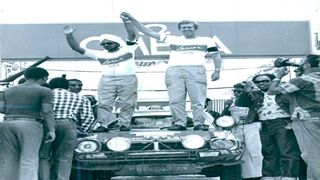
The 1976 Safari Rally Winner, Joginder Singh and David Doig the finishing ramp at Kenyatta Conference Centre.
| File | Nation Media GroupMotorsport
Premium
How Mitsubishi’s return to ‘96 Safari changed the terrain
What you need to know:
- Kenya prepares to return to the World Rally Championship for first time since 2002
- The car manufacturer returned after 20 years of absence with a tactical and technological revolution, forcing other teams to change tack
- Everybody copied the strategy thereafter, and Makinen went on to win in 1999 and 2001.
The 1996 World Rally Championship Safari Rally is most memorable as an event in which first-timer Tommi Makinen and Mitsubishi Ralliart Team produced a stellar performance, changing the Safari’s DNA forever.
The competition changed from an event in which cautious drivers adopted a wait-and-see approach while engaging in an endurance marathon, to a European-style gun-to-tape sprint.
Mitsubishi made a majestic comeback after 20 years of absence with a tactical and technological revolution which forced other teams to change tack after 1996.
Mitsubishi was dominant in the early 70s, with Joginder Singh winning in 1974 and 1976 in the tiny Colt Lancer car which was low in power but with a better gear ratio in a star-studded field that featured, among others, the space-age technology of the all-powerful Lancia Stratos and the tireless workhorse Peugeot 504.
But Mitsubishi disappeared from the WRC Safari thereafter, missing the Group B golden era of raw power, dangerous fire-spitting supercars, only to return in 1994 when Japanese Kenjiro Shinozuka, 10th in 1976 Safari, now racing under Tusk engineering team with full factory backing, returned as one of the rank outsiders but still managed a second position behind Kenyan Ian Duncan.
Speed
The Mitsubishi Evolution had the speed but not the Safari experience borne out of decades-long development tests of Toyota, Ford, and Subaru.
If Mitsubishi were to challenge for WRC crown seriously, commonsense dictated that they needed European car-tuning technology by going the Subaru.
Subaru had teamed up with Prodrive of UK to establish a presence in the WRC in the late 80s. Previously, Subaru had raced under Fuji Heavy Industries’ Motorsports Division - Subaru Technica International (STi).
Mitsubishi Motor Corporation (MMC) followed the Subaru path and paired with Andrew Cowan and Derrick Dauncey of UK Motorsports (ACMS) Ltd Ralliart to prepare and race their cars. Their early signing was Makinen, a driver with the natural flair of the “Original Flying Finns” and Midas touch.
In 1996, Makinen easily won the season-opening Monte Carlo. The late Andrew Cowan, enjoying a long relationship with Mitsubishi, having finished third behind Joginder and Robin Ulyate in 1976 Safari, was elated. They were returning home to Kenya.
The Safari attracted a healthy field of 11 FIA Priority “A” drivers, among them world champion Colin McRae/Kenneth Eriksson/Piero Liati (Subaru Impreza); 1992 Safari champion Carlos Sainz/Stig Blomqvist (Ford Escort); and Makinen and Shinozuka (Mitsubishi EVO 3).
Subaru Prodrive complemented their presence with Subaru Motor Sports Group of Noriyuki Koseki supporting Patrick Njiru, Hideaki Miyoshi, and the late Tanveer Alam.
Duncan was privately entered in a factory Toyota Celica GT4 Turbo since the factory team was serving a one –year ban for using illegal turbo restrictor in Spain the previous year.
Excitement was palpable after the Safari, which the previous year was a victim of the new FIA “rotational” format whereby some events missed the WRC full status and counted only in the Two Litre Two-wheel category (won by Azar Anwar in a Daewoo Cielo), regained its full status.
Early on day one, McRae and Eriksson stormed into the lead before Makinen attacked, driving flat out, and showing the full potentials of the EVO 3 until a puncture put him behind. Therefore, Eriksson returned back to Kenyatta International Convention Centre first in a rain-enforced shortened leg.
One thing emerged, all the three were sprinting as if they were in Europe. Those who attempted to challenge suffered irreparable struts damages like Sainz and Blomqvist. McRae was neither lucky while Duncan preferred sensibility, rather than bravado.
Something strange was happening in the Mitsubishi tent. They changed low-lateral links, upper links, toe links, uprights, and dampers in each corner of the car within a 20-minute time frame in every service halt.
Dauncey explained to Dirt Fish Podcast recently: “It was a really big team effort, because Tommi came back in (to service), handed the car to us and it was down to us to get the car back out to him in 20 minutes.
There were eight people on the corners and specialists, but the specialists could also work on the car.
“We got to the first service and we laid everything out; Subaru was servicing next to us and we started changing every corner, I can remember a couple of senior Subaru guys looking over and smiling and thinking that we were hitting massive problems.
They also opted to use engineer Pekka Siltanen’s damper design – with Öhlins making the parts.
“The car left and then came back into the second service at the same location and we did the same thing; I could see the penny dropping on Mr (David) Richards’ face and I think he suddenly realised what we were doing.
The old Safari was buried in 1996, a new sprint concept conceived.
Everybody copied the strategy thereafter, and Makinen went on to win in 1999 and 2001.



